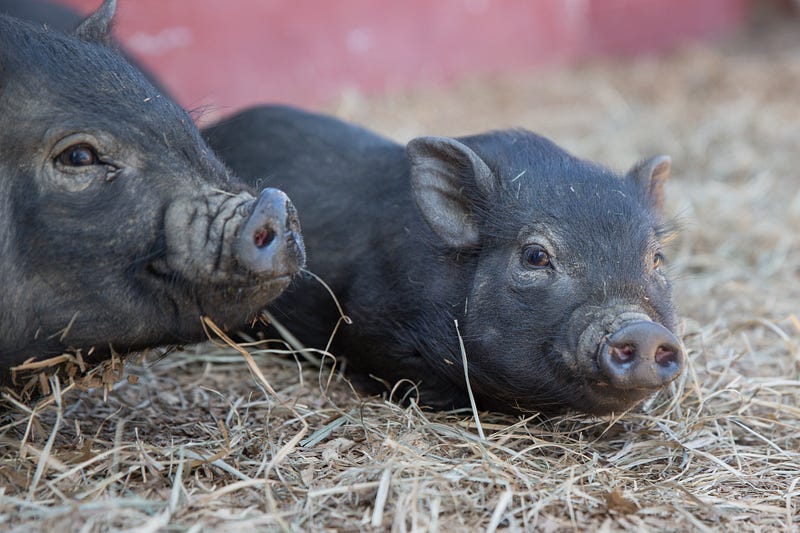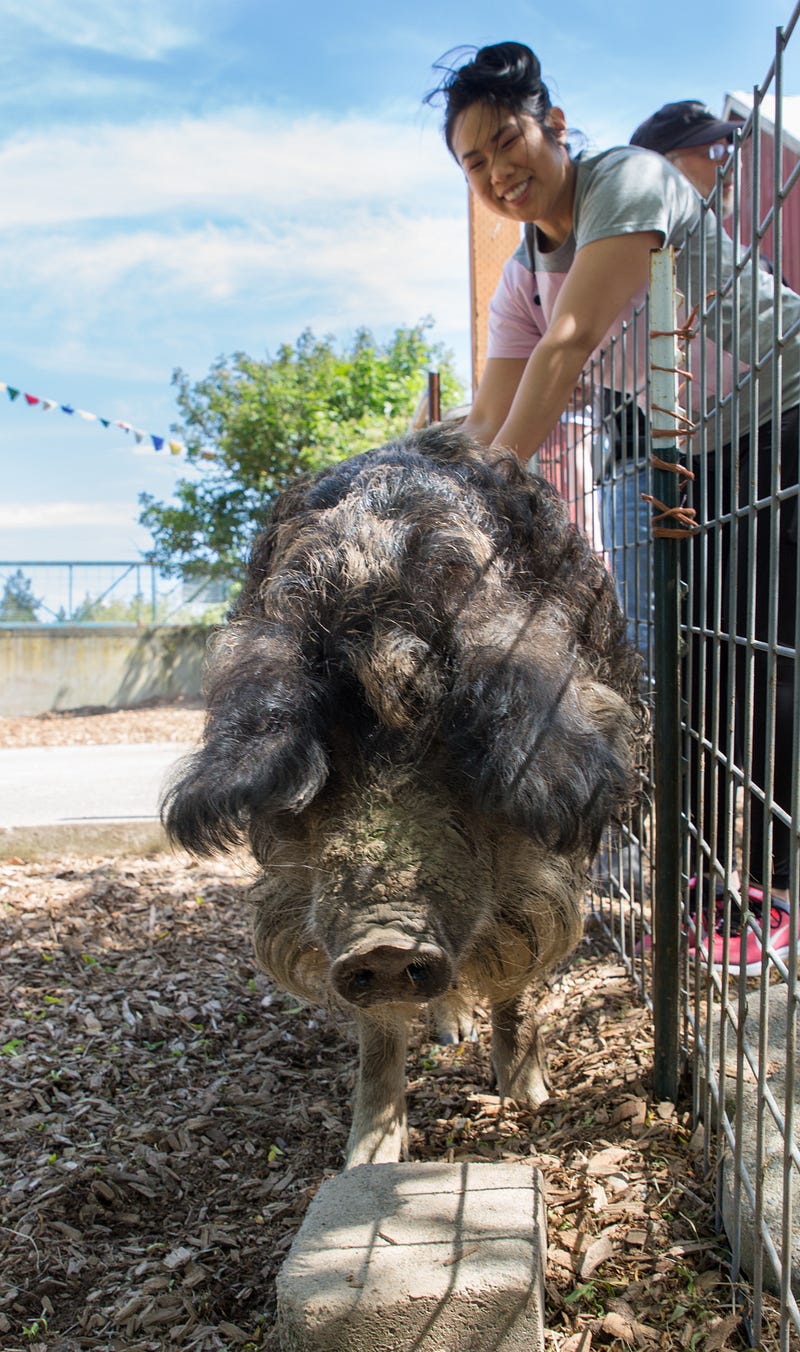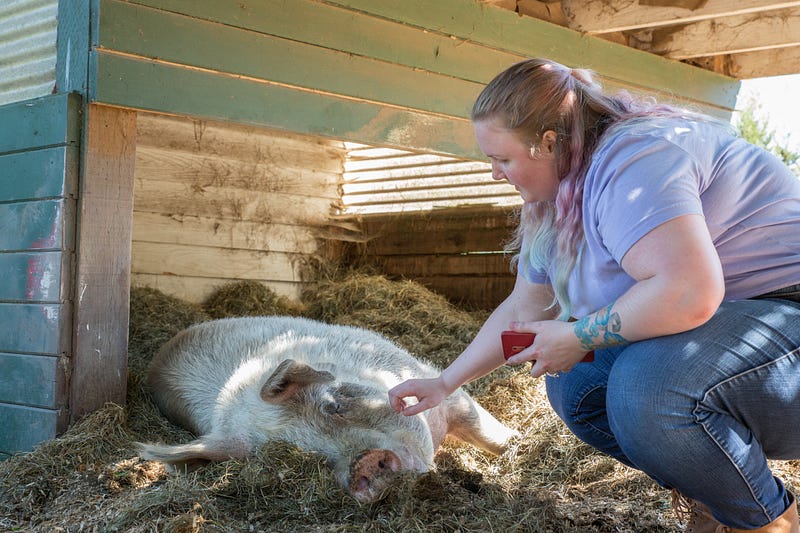Pigs Peace
Judy Woods, director and founder of the Pig Peace Sanctuary, gives pigs a safe and loving home at her farm in Stanwood, Washington
Story by JACK CARBALLO | Photos by HARRISON AMELANG

Tony, a 5-foot-long slumbering farm pig, nestles his head a bit more comfortably in the hay, shuffling some around and burying my ankles. I pet the sweet boy, and he cracks his eyes open a bit while Judy Woods, 63, recounts tales of redemption, friendship and love between the pigs she rescues at Pig Peace Sanctuary.
Judy is the founder and director of the sanctuary, a nonprofit organization sitting on 39 acres of forest, meadows, trails and ponds in Stanwood, Washington. The sanctuary’s slogan is: “a safe haven of love for pigs and their friends.” It is managed by Judy and a board of directors.
As she shows me around the different enclosures, little oinking friends, fast and slow, big and small, merrily prance up to each fence we approach, warmly welcoming us on a beautiful sunny Tuesday. Oinks are heard at varying volumes and distances amongst the acres, some pigs roam the grasslands rustling about, while some plop down deep in slumber. The herb-scented smell of hay wafted about with each passing breeze.
I’m introduced to each pig and learn a little bit about how each one ended up at the sanctuary. Some were sad stories, some were happy, but what was obvious on the expressions of these animals was tranquility and joy.
The profound tone of passion and respect Judy carries as she tells harrowing tales of scared piglets growing up into loving creatures, who love nothing more than to munch dandelions with their brothers and sisters, matches that of family and friends.
In a small sheltered hay barn, large farm pigs lay down in knee-high mounds of hay, which is where I’m introduced to Albert.
In one tale Judy tells me, Albert was to be put under anesthesia for a veterinarian visit. Similarly to humans, Judy says, pigs come out of sleep very disoriented; wanting to move around and make sense of their surroundings. In the same way, people will naturally be more relaxed to the situation if a friend or family member is nearby.
Judy put one of Albert’s friends in the room with him as he was waking up, discovering it had the same effect as it would on humans. Albert would oink for comfort; his friend would oink back to let him know everything was alright.
“Oink, ‘Are you there?’ oink, ‘Yes, you’re fine just sleep it off,’” Judy says. “And it will be like that, back and forth a thousand times.”
Judy says Albert was supposed to go back into another location on the property with the rest of the sounder, which is a group of pigs. However, he’s stubbornly made the small hay barn his own little spot to lounge in.
To the sound of Judy’s voice, a large head rustles from beneath the hay and pokes through the mound, making himself visible. Albert lets out a greeting “oink” as he approaches us.
As we say goodbye to Albert and his sleeping buddies, we pass by a hay-bed barn with a missing wall to allow fresh air and sunlight. Nestled together are three large farm pigs, which Judy says were running loose in Seattle when they were just piglets. It was a week before Christmas time, Judy says, and as wild pigs are terrified of humans, they had to be individually trapped.
“All I can guess is, if it’s a week before Christmas and you’re a little piglet,” Judy says, “you’re going to be somebody’s Christmas roast.”
After being taken in by Judy as wild piglets, the three grew up and have lived happy lives ever since.
A Seattle native, 9-year-old Judy obsessively checked out “Charlotte’s Web” from her school’s library, her heart, full-throttle invested in wanting to help Wilbur the pig.
“I was born in a meat-eating family; my grandfather was a famous butcher,” Judy says. “But I was also raised to be kind to animals.”
She recalls being 15 years old reading the newspaper in her family’s living room, a sausage whistling, cooking just in the kitchen. She was reading an editorial about seal slaughtering in Canada, in which the author condemned meat-eaters as hypocrites if they feel sorry for the seals but continue to farm animals for food.
It was that profound shell-shock of a moment that caused her 15-year-old self to step back and decide to stop eating meat for good.
More than 99 percent of farm animals in the U.S. are raised in factory farms, according to the American Society for the Prevention of Cruelty to Animals. These industries focus on efficiency and profit at the cost of animal welfare, according to the same source.

The conditions of animals used in animal agriculture are those of misery, depression, frustration and heartache; compromising both their physical and mental health.
Pigs in the animal farming industry spend most of their adult life in small metal barred cages, called “gestation crates,” according to Animal’s Angels Investigation and Advocacy. Most often used to keep pregnant sows in, the cages only offer enough space for the pig to take one step back or forth, but not enough to even turn around. Here, they must eat, sleep, urinate and defecate on grounds that are bare concrete as opposed to hay.
Animal’s Angels Investigation and Advocacy also reports that these conditions often lead to severe mental, physical and emotional health problems and distress.
Judy says one of the biggest problems with the animal agriculture industry is that not enough people are educated on the realities of it, and people believe the corporate message of humane animal butchering. For her, time spent participating in animal rights protests and movements illuminated the political agenda driving the meat and dairy industry.
“I live with the victims of the industry, so I have to be their voice to our species,” Judy says. “But you won’t find offensive and shameful literature here, if it’s from Pigs Peace Sanctuary, it’ll be an invitation for information.”
Judy’s goal is not to shame meat-eaters for being raised to adhere to certain social norms and cultures, but rather help them find an inherent human compassion deeper within through education and interaction with the animals.
“In the past I’ve had that kind of harsh, shameful information here,” Judy says. “I’ve seen people pick it up, put it down and walk right off the property.”
In the early decades of factory farming, most people were looking the other way as climate change hadn’t been as prominent an issue. At the time, animal agriculture was also only seen as a cheaper efficient form of food manufacturing.
Judy recalls the influx of pigs to the U.S., and them being advertised as household pets in the 1980s in the news and on TV.
“They were selling for about $5000 per pig, so I would never buy a pig for that,” Judy says, “But I’m thinking, ‘Oh I could have a pig sanctuary one day,’ because I knew about the factory farm situation. Then there was a pig running loose in Seattle, and that was the first rescue. Wilbur.”
Judy says she found herself overwhelmed in terms of all of the required resources to start caring for larger pigs who were saved from slaughter. The books she read on how to raise pigs vastly differed from her own experience around them, likely because breeders or farmers wrote the books.
Studying social interactions of pigs, between each other as well as toward humans, taught her more about how they act than any of the books did, Judy says.
“I actually paid more attention to the animal and their behavior,” Judy says, “and that’s how I know pigs.”
The sanctuary is now home to over 60 pigs that are prospering with a newfound appreciation for their lives.
“When the sanctuary started I was on my land in Arlington, and when we bought this farm I put it in the sanctuary’s title,” Judy says. “[The pigs] own the title, I live with them they don’t live with me. They will never be displaced.”
The sanctuary was founded from Judy’s retirement working as a nurse, as well as some inheritance after her mother passed away. She worked as a nurse for the first 10 years of owning the sanctuary. At the time, she’d also be doing research and allocating finances toward resources for the sanctuary.

She recalls buyers and owners being judgmental and contemptuous of the organization, deeming them “throwaway pigs.”
The majority of pigs Judy takes in are from families who weren’t well equipped to care for a pig, both in terms of research and commitment. Judy says when animal control agencies or sheriff offices contact her regarding a pig they’d found or rescued, it is often a neglect or abuse situation.
“Most calls are when the pig is no longer a cute piglet,” Judy says, “I have heard every story of why [people] can’t keep them.”
Oftentimes, those who brought their pigs to Judy for care had fallen through on their promises to maintain contact and support after they’d given her their pig. Judy says this was disappointing, and she’s now very strict with who she says yes to. She says this has always been a letdown for her, because she firmly believes people will do right by their pig.
But now, if somebody were to give her a pig and never support her or the organization again, she would be okay with that. For Judy, what people say doesn’t matter, because she knows she herself will do right by that pig.
“I started this sanctuary because I loved a pig,” Judy says. “I thought, ‘If I ever had to part with her, I would pay anything to have her live in a place like this.’ I would take three jobs to have her live where I knew I would never have to worry again.”
The sanctuary also owns an all-vegan grocery store in Seattle called Vegan Haven, run by volunteers and three managers, where all profit goes toward the sanctuary.
It started when a board member of the organization approached her in 2005 and sold the idea as a turnkey operation; ready to go, just in need of approval. Judy quickly learned it wouldn’t be this easy.
By the time the 2008 recession hit, donations had already been plummeting. Judy says when they bought the store, donations had already been dropping then also.
For the first five years, the store did not profit directly toward the sanctuary because funds from the store were still being used to build it up. Most donors and customers had been misled into thinking that at this point, the sanctuary was receiving the profit. This contributed to a drop in donations, as shoppers were under the impression their purchases were going toward funding the sanctuary, so they would buy from the store instead of donating.
With renovations, patience and support, the store has grown to the thriving market it is today.
“It’s never cost the sanctuary anything, if it ever did, I’m getting rid of it,” Judy says. “It has to be self-supporting, and it has been since we’ve owned it, but for the first five years there was nothing.”
It is currently making good profit and business, especially with the real estate boom and influx in Seattle. According to PETA, Seattle is also the ninth best city in the U.S. for vegan food options.
Shelly Schnabel, one of the managers at Vegan Haven and vegan herself, describes it as the best job she’s ever worked.
“It’s been such an uplifting experience,” Schnabel says, “People always have good things to say and are very supportive of an all-vegan store.”
Schnabel says while the store purchases items at wholesale (standard) pricing, they price the products at a smaller markup. This aligns with their goal of making veganism affordable to everybody, and the use of volunteers and only three managers makes this possible. After rent, payroll and inventory bills, all profit goes toward the sanctuary.

“Our tiny store doesn’t quite fit all of our products, customers and especially the massive amount of compassion that all of our volunteers bring with them everyday,” Schnabel says. “Soon enough, we’ll expand and make an even bigger impact on our community and the animal rights movement.”
Schnabel also mentioned that the nonprofit has been incredibly successful, and has grown by 50 percent every month over the last year.
“Judy is super inspiring,” Schnabel says, “Everything she does for animals is really important, and it’s very rewarding to be a part of.”
Judy notes that while owning a store was never her plan or idea for the sanctuary, she welcomes the love and support from customers and vegan advocates.
However, for Judy, one of her favorite things is watching perspectives transform before her eyes, both on part of the pigs and humans. Some pigs would come in terrified of humans, and humans terrified of pigs. She has the privilege to watch a bond form between two species of life, and the emotional and personal growth they find through these interactions.
Long and many are the tales of change-of-heart at the Pig Peace Sanctuary. While Judy cherishes these moments, even closer to her heart are the happy and healthy friends and families of pigs that she gives a safe haven to, whose joy and love is both immeasurable and invaluable.
Judy recounts a tale of friendship between two pigs, a 14-year-old Ramona and 5-year-old Maggie. Ramona had lived a long and happy life but was now too old to live properly, and had to be euthanized. When the vet arrived, Judy had Maggie close to Ramona to console her in her final moments.
“The vet says, ‘Are we going to want her to leave?’ I said, ‘No, she’s not leaving,’” Judy says, “This is her best friend.”
She says the vet was a newly trained one and wasn’t as understanding and receptive, but allowed it.
Judy says the moment Ramona’s heart stopped, Maggie had a visceral response and got up and left. She recalls the vet packing up his equipment and asking, “Did you see that?”
Judy described Maggie’s grief by her hanging around the grave, refusing to eat or walk around and crying. She characterized a pig’s cry as soft, high pitched drawn out groans.
Maggie would sleep where Ramona died for days on end and cry. Judy says she’s observed this type of grief ritual last up to six months with deaths between pig friends.
“I’m trying to teach the industry about compassion with pigs and how much they need each other,” Judy says. “It’s this relationship that has to be respected, not only acknowledged.”
